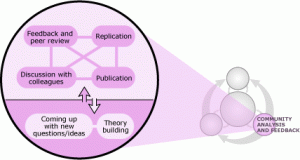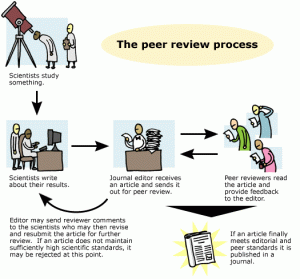3 Information Communication
Andrea Bierema and Sara Miller
Learning Objectives
- Explain the peer review process for scientific articles.
- Describe the different types of information sources that describe scientific research.
- Identify that information may be perceived differently based on the format in which it is packaged.
- Identify that one’s personal information and online interactions affect the information one receives and the information one produces or disseminates online.
- Evaluate an information source, including its headline and graphs, if present.

Community Analysis and Feedback
One of the main elements of the science flowchart is “community analysis and feedback.” Members of the scientific community play several essential and direct roles:
Peer review does the same thing for science that the “inspected by #7” sticker does for your t-shirt: provides assurance that someone who knows what they’re doing has double-checked it. In science, peer review typically works something like this:
- A group of scientists completes a study and writes it up in the form of an article. They submit it to a journal for publication.
- The journal’s editors send the article to several other scientists who work in the same field (i.e., the “peers” of peer review).
- Those reviewers provide feedback on the article and tell the editor whether or not they think the study is of high enough quality to be published.
- The authors may then revise their article and resubmit it for consideration.
- Only articles that meet good scientific standards (e.g., acknowledge and build upon other work in the field, rely on logical reasoning and well-designed studies, back up claims with evidence, etc.) are accepted for publication.

The scientific community provides a system of checks and balances that ensures the quality of scientific work, double-checks arguments, and confirms that ideas are evaluated fairly. This scrutiny can serve a few different functions from fact-checking to whistleblowing.
Article Types
Scientists distribute information about their ideas in many ways (informally communicating with colleagues, making presentations at conferences, writing books, etc.), but among these different modes of communication, peer-reviewed journal articles are especially important.
A journal article is a formal, souped-up version of the standard high school lab report. In journal articles, scientists (usually a group of collaborators) describe a study and report any details one might need to evaluate that study: background information, data, statistical results, graphs, maps, explanations of how the study was performed and how the researchers drew their conclusions, etc. These articles are published in scientific journals, either in print or on the internet. Print journals look much like any magazine, except that they are chock full of firsthand reports of scientific research. Journals distribute scientific information to researchers all around the world so that they can keep current in their fields and evaluate the work of their peers. Journal articles neaten up the messy process of science by presenting ideas, evidence, and reasoning in a way that’s easy to understand—in contrast to the often circuitous (and sometimes tedious) process of science (see the “Nature of Science” chapter for more information). Check out the video below to learn more about the different ways in which scientific research is published.
For closed captioning or to view the full transcript see the video on YouTube. or click on the “YouTube” link in the video.
Headlines
- Trans-fat free!
- Ethanol production: an eco-nightmare?
- Cancer researchers discover new hope.
- Major petroleum company acknowledges the reality of global warming.
- Clinically proven to reduce the appearance of wrinkles!
The above statements aren’t exactly the headlines you’d find in a scientific journal, but they are examples of the sorts of scientific messages that one might encounter every day. Because science is so critical to our lives, we are regularly targeted by media messages about science in the form of advertising or reporting from newspapers, magazines, the internet, TV, or radio. Similarly, our everyday lives are affected by all sorts of science-related policies from what additives are allowed (or required) to be mixed in with gasoline, to where homes can be built, to how milk is processed, but you don’t have to take these media messages and science policies at face value. Understanding the nature of science can help you uncover the real meaning of media messages about science and evaluate the science behind policies.
Exercise
Let’s practice!
For closed captioning or to view the full transcript see the video on YouTube. or click on the “YouTube” link in the video.
Graphs
Graphs (especially those that contain a reference) can be a great information source to use as evidence but sometimes they can be misconstrued to support a different claim to the untrained eye. Watch the video below to learn more about misleading graphs!
For closed captioning or to view the full transcript see the video on YouTube. or click on the “YouTube” link in the video.
Curious how statistics can be misleading? Check out this TED-Ed Talk to find out!
Source Evaluation
Every day, we are bombarded with messages based on science: the nightly news reports on the health effects of cholesterol in eggs, a shampoo advertisement claims that it has been scientifically proven to strengthen hair, or the newspaper reports on the senate’s vote to restrict carbon dioxide emissions based on their impact on global warming. Media representations of science and science-related policy are essential for quickly communicating scientific messages to the broad public. However, some important parts of the scientific message can easily get lost or garbled in translation. An original piece of scientific research may be interpreted many times over before it reaches you. First, the researchers will write up the research for a scientific journal article, which may then be adapted into a simplified press release, which will be read by reporters and translated yet again into a newspaper, magazine, internet article, and so on. Just as in a game of telephone, errors and exaggerations can sneak in with each adaptation. Additionally, the setup of articles meant for the general public tends to focus on the results and their potential meanings rather than the research background and methods.
Drs. Dar Meshi and Maria Molina, researchers from Michigan State University, found a link between problematic social media use and accepting misinformation. See the secondary article published in MSUToday to learn more about the study’s findings.
Exercise
Before getting into the details on how to analyze information sources, let’s consider the following hypothetical article. What are some things to consider while evaluating this article? In the image, click on the exclamation point icons to learn about some concerns regarding this article.
For closed captioning or to view the full transcript see the video on YouTube. or click on the “YouTube” link in the video.
For closed captioning or to view the full transcript see the video on YouTube. or click on the “YouTube” link in the video.
Attribution
This chapter is a modified derivative of the following article:
Understanding Science. 2020. University of California Museum of Paleontology. 11 June 2020 <http://www.understandingscience.org>.

